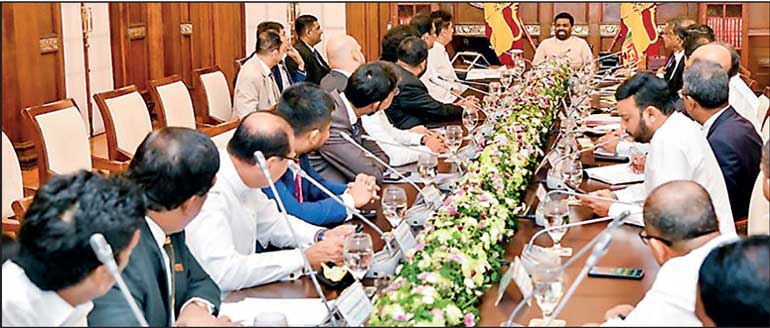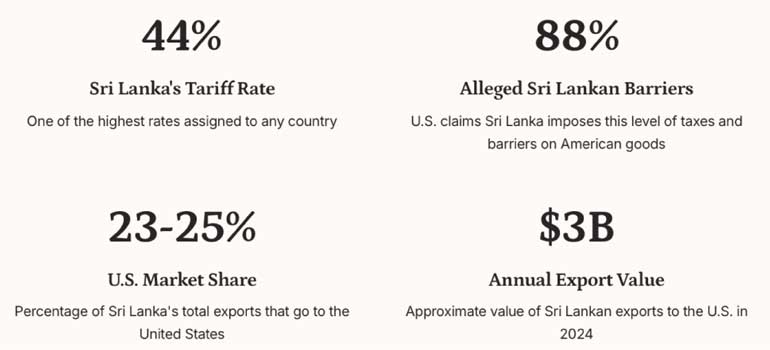Saturday Apr 19, 2025
Saturday Apr 19, 2025
Friday, 18 April 2025 00:20 - - {{hitsCtrl.values.hits}}

A meeting of party leaders, convened by President Anura Kumara Disanayake, was held recently (10) at the Presidential Secretariat to discuss the impact of recent US tariffs on Sri Lanka’s economy and the proposals to discuss this with the US government

 Recent concerns over Sri Lanka’s alleged imposition of cumulative taxes and trade barriers—reportedly amounting to 88% on US goods, particularly automobiles, alcohol, and electronics—have reignited scrutiny of the country’s trade posture. In response, the United States is said to apply tariffs of up to 44% on certain Sri Lankan exports, reinforcing perceptions of asymmetry and deepening bilateral trade tensions.
Recent concerns over Sri Lanka’s alleged imposition of cumulative taxes and trade barriers—reportedly amounting to 88% on US goods, particularly automobiles, alcohol, and electronics—have reignited scrutiny of the country’s trade posture. In response, the United States is said to apply tariffs of up to 44% on certain Sri Lankan exports, reinforcing perceptions of asymmetry and deepening bilateral trade tensions.
For a nation in the midst of economic recovery, such tensions with a key partner like the United States risk undermining much-needed investment and access to international markets. Over the next 90 days, Sri Lanka must demonstrate policy agility and diplomatic maturity to reset the tone of its trade relationship with the US. The objective should be to reframe the narrative, signal readiness for reform, and pursue a mutually beneficial framework that balances economic pragmatism with national interest.
Diplomatic engagement as a starting point
Immediate high-level engagement by the Sri Lankan Ambassador to the United States with the Office of the United States Trade Representative (USTR) is essential. A dedicated envoy with the required competence and US connections, empowered to negotiate temporary concessions and explore avenues for reciprocity, should be appointed. Reviving the long-dormant Trade and Investment Framework Agreement (TIFA) dialogue could provide a formal platform to address tariff concerns and initiate discussions on trade facilitation and regulatory cooperation.
Rationalising the tariff structure
Sri Lanka’s elevated tariffs in select sectors were originally designed to safeguard foreign exchange reserves and protect government revenue. However, a short-term review of the tariff structure is now warranted. A selective, phased reduction of duties on critical US goods—particularly those with limited domestic substitutes or strategic importance, such as renewable energy equipment or medical technology—could ease tensions without undermining fiscal stability. The aim is not blanket liberalisation, but a pragmatic recalibration that fosters trade and investment.
Structured bilateral concessions
To build goodwill, Sri Lanka should offer targeted trade concessions in sectors of interest to US exporters, while seeking improved access for high-potential Sri Lankan products such as apparel, seafood, and rubber-based goods. A pilot trade facilitation initiative—such as expedited customs clearance for designated US imports—could serve as a confidence-building measure and demonstrate the country’s commitment to regulatory reform.
Reforms within a broader framework
Sri Lanka’s broader economic reform agenda, supported by the International Monetary Fund, presents an opportunity to integrate trade reforms into a wider effort to enhance national competitiveness. Modernising import licensing procedures, digitising customs operations, and phasing out para-tariffs would help establish a more predictable and transparent trading environment—qualities essential for restoring investor confidence.
Announcing an interim framework
Within 90 days, Sri Lanka should present a clear “Interim Trade Facilitation Framework” to the United States. This document should outline short-term tariff adjustments, a mutual review mechanism, and areas for future cooperation. Such a move would not only demonstrate intent, but also position Sri Lanka as a fair, reform-oriented partner committed to rules-based trade.
Conclusion
Recalibrating Sri Lanka’s trade relationship with the United States is no longer merely a diplomatic concern—it is an urgent economic imperative. With $ 3 billion in exports at stake—including key sectors such as apparel, tea, and rubber—timely and strategic action is critical. The US remains one of Sri Lanka’s most significant export markets. However, shifting global trade dynamics, declining preferential access, and intensifying competition from regional players have exposed our vulnerabilities. Without swift and targeted intervention, Sri Lanka risks losing vital foreign exchange and thousands of jobs. To safeguard and grow this partnership, Sri Lanka must align with evolving US market expectations, particularly in areas like sustainability, traceability, and digital trade. Exporters need robust support to adapt, while the government must drive a coherent, forward-looking trade strategy—anchored in high-level diplomatic engagement and strong private sector collaboration.
A renewed and mutually beneficial US–Sri Lanka trade relationship can be a cornerstone of our economic recovery and long-term resilience. To achieve this, we must urgently focus on tariff and para-tariff liberalisation, refresh our National Export Strategy, deepen key trade partnerships, review our international engagement, and advance proactive economic diplomacy. Collective action, clear vision, and determined leadership are essential to securing a better deal for Sri Lanka.
References:
https://www.advocata.org/commentary-archives/2025/04/09trump-tariffs-expose-sri-lankas-uncompetitive-trade-policy-advocata.
https://www.project-syndicate.org/commentary/asean-should-admit-timor-leste-sri-lanka-to-counter-trump-tariffs-by-r-m-manivannan-2025-04
(The writer teaches Accounting and Finance at the University of Buckingham, UK, and is currently researching effective global debt management indicators that offer early warning signals.)